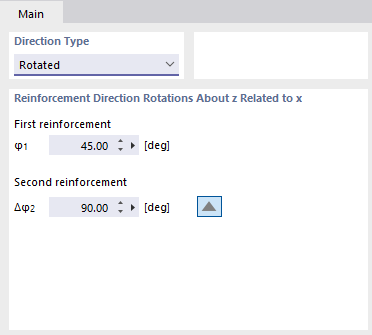For the reinforced concrete design of surfaces, the program needs the information on how the reinforcement directions φ1 ("main reinforcement") and φ2 ("transverse reinforcement") of each surface are defined. Both directions are usually aligned orthogonally and parallel to the surface axes x and y. The "Reinforcement Directions" type allows you to properly arrange the reinforcement direction of the individual surfaces.
Direction Type
First Reinforcement Direction in x / y
There is a direction type preset, where the first reinforcement direction (φ1) is oriented as parallel to the x-direction of each surface. In the case of curved surfaces, the x-axes of the finite surface elements serve as a reference.
If you want to arrange the direction φ1 of the "main reinforcement" as parallel to the local y-axis of a surface, either change the direction type using the list or define a new direction type with the corresponding specification.
User-Defined
If the reinforcement is not parallel to the surface axes or the directions φ1 and φ2 are not orthogonal, define the reinforcement direction using the "Rotated" option.
Specify the angle φ1 of the direction for the "first reinforcement". It describes the angle between the reinforcement direction 1 ("main reinforcement") and the local x-axis of the surface. You can only enter positive values. Thus, the reinforcement direction is rotated clockwise around the positive local z-axis.
In the same way, define the angle φ2 for the "second reinforcement". This angle describes the rotation of the reinforcement direction 2 ("transverse reinforcement") with regard to the x-axis of the surface. Use the
![]() button to switch between the input of the angle φ2 and the difference Δφ2 related to Direction 1.
button to switch between the input of the angle φ2 and the difference Δφ2 related to Direction 1.



